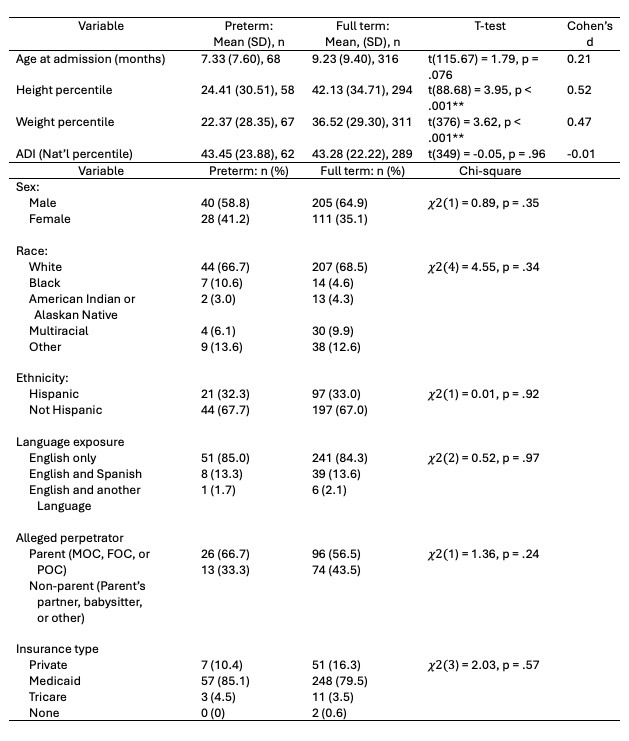Child Abuse & Neglect 1
Session: Child Abuse & Neglect 1
336 - A Comparison of Premature and Full-Term Infants with Inflicted Traumatic Brain Injury (iTBI); Sociodemographic Variables, Injury Characteristics, and Outcomes.
Sunday, April 27, 2025
8:30am - 10:45am HST
Publication Number: 336.3737
Erin Klements, University of Colorado School of Medicine, Denver, CO, United States; Amy Connery, University of Colorado School of Medicine, Aurora, CO, United States; Michael Dichiaro, University of Colorado School of Medicine, Aurora, CO, United States; Robin L. Peterson, University of Colorado School of Medicine, Aurora, CO, United States; William Anastasiadis, Children's Hospital Colorado, Loveland, CO, United States

Erin Klements, MD
Resident
University of Colorado School of Medicine
Denver, Colorado, United States
Presenting Author(s)
Background: Inflicted traumatic brain injury (iTBI) is a leading cause of serious brain injury in infants and causes significant morbidity and mortality. Premature birth ( < 37 weeks gestational age (GA)) is a risk factor for iTBI, but no prior studies have examined how preterm and term infants with iTBI may differ.
Objective: To evaluate whether child or family/contextual variables differ between preterm and term infants with iTBI, and to assess for differences in injury severity, mortality, and developmental outcomes.
Design/Methods: The study was approved by the Institutional Review Board of our institution. This was a retrospective analysis of patients diagnosed with iTBI from 2012-2020 who were ≤42 months at the time of injury (N=384). Three sets of twins met these criteria, so one twin was selected at random for inclusion. 68 patients were born < 37 weeks GA. Continuous variables were examined for extreme outliers and datapoints >3SD beyond the mean were Winsorized. We used independent samples t-tests and chi-square analyses to compare child, family/contextual, and injury-related variables, as well as developmental outcomes at 6, 12, and 24 months of age as measured by the Bayley Scales of Infant Development for preterm and term groups. As is standard practice, ages for the preterm infants were adjusted for GA until 24 months chronological age.
Results: The preterm group was significantly smaller in height and weight percentile at the time of injury. There were no other significant differences between the two groups on child, family/contextual, or injury-related variables. The preterm group scored significantly higher than the term group in the Bayley cognitive subdomain at the 6 and 12 month evaluations, but not at 24 months. There were no differences in Bayley language or motor scores.
Conclusion(s): The lack of significant differences between the preterm and term groups in demographic and socioeconomic variables suggests that factors inherent to prematurity may increase risk for iTBI. Alternatively, unmeasured variables could contribute to the increased risk. Our data also shows that injury severity is similar for preterm and term infants. The preterm group scored significantly higher in the Bayley Cognitive subdomain using age adjusted scores. This suggests that age correction for GA may be inappropriately elevating the cognitive scores of this group. Consistent with this hypothesis, the preterm group earned similar cognitive scores to term group at 24 months, by which time no ages were adjusted for GA. Future studies should compare developmental outcomes for these two groups based on chronological age.
Table 1: Comparisons of Infant and Sociodemographic Variables
 ** = p < 0.01
** = p < 0.01Table 2: Comparisons of Measures of Injury Severity

Table 3: Group Statistics and Comparisons of the Bayley Cognitive Scores at the 6, 12, and 24 Month Evaluations.
 * = p < 0.05
* = p < 0.05
